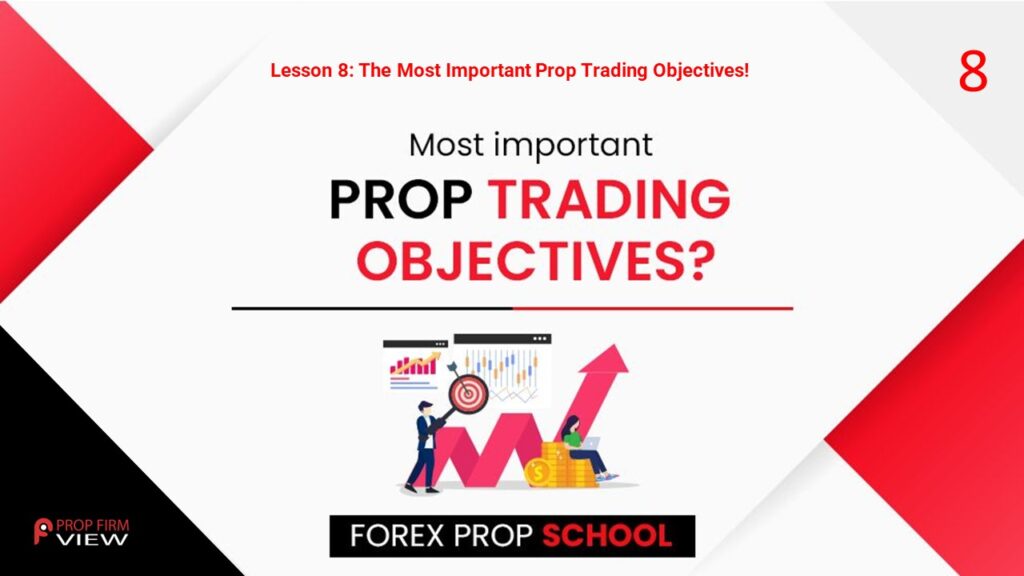The Most Important Prop Trading Objectives!

In the world of prop trading, there are several key objectives that traders aim to achieve to ensure success and profitability. In this blog post, we will explore some of the most important prop trading objectives, including profit target, daily drawdown, maximum drawdown, minimum trading days, maximum trading period, leverage, and profit split.
Most Important Trading Objectives
Understanding and achieving these objectives is crucial for prop traders to thrive in this competitive industry.
Profit Target
profit goals for different challenges. By consistently meeting profit targets, traders can ensure profitability and measure the effectiveness of their trading strategies. This ensures moving toward the next phase, whether it is evaluation phase 2, phase 3, or the Funded Phase.
Daily Drawdown
Daily drawdown refers to the maximum allowable loss a trader is willing to incur in a single trading day. A crucial risk management objective helps control losses and preserve capital. In the Prop Industry, Prop firms have set daily Drawdown, which is typically 5% with two-step funding programs, while for one-step and instant funding programs, the daily drawdown can be slightly lower. By setting a daily drawdown limit, traders limit the adverse impact of potentially losing trades. Strictly adhering to this objective ensures traders do not expose their capital to excessive risks on any given day.
Maximum Drawdown
Similar to daily drawdown, maximum drawdown sets a limit on the overall loss a trader is willing to tolerate during a specific period. It represents the largest peak-to-trough decline in the trader’s account balance. Prop Firms usually give traders the Maximum Drawdown Limit, which can be, in most cases, between 8% and 12%. Traders cannot cross this limit, or this will be the ultimate violation.
Minimum Trading Days
Prop trading firms often establish a minimum number of trading days as an objective. Minimum trading days objective also helps traders avoid impulsive or emotional decision-making, as they are committed to a structured trading routine. Prop Firms usually give Minimum trading Days so that traders trade for at least the given time period.
Maximum Trading Period
To prevent prolonged exposure to the market, prop firms often set a maximum trading period for each phase. Prop firms make sure that traders achieve the required profit target by imposing a maximum trading period.
Leverage
Leverage is an important aspect of prop trading, allowing traders to amplify their exposure to the market and potentially increase profits. However, using leverage responsibly and setting it as an objective is essential. Prop firms need traders to strike a balance between utilizing leverage to maximize returns and managing the associated risks. They usually have different leverage for different trading instruments.
Profit Split
In prop trading, profit split refers to the distribution of profits between the trader and the trading firm. It is an important objective to establish a fair and transparent profit-sharing arrangement. A clear and mutually beneficial profit split objective ensures a harmonious partnership between the trader and the firm, fostering motivation and long-term commitment. Some prop firms have fixed profit sharing, but others have profit split that can increase if traders scale up their accounts.
Conclusion
Proprietary trading comes with its own set of objectives critical for success. Traders must focus on achieving profit targets, managing daily and maximum drawdowns, maintaining a minimum number of trading days, respecting the maximum trading period, using leverage responsibly, and establishing a fair profit split. By diligently pursuing these objectives, prop traders can navigate the complexities of the financial markets, mitigate risks effectively, and enhance their chances of long-term profitability.
These Trading Objectives are a way to ensure smooth running. Traders must comply with them to get the status of “Funded Trader.”











